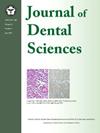Exploring gender-specific prognostic factors and survival outcomes in oral squamous cell carcinoma: Insights from a Taiwanese cohort
IF 3.1
3区 医学
Q1 DENTISTRY, ORAL SURGERY & MEDICINE
引用次数: 0
Abstract
Background
/purpose: Oral squamous cell carcinoma (OSCC) is a prevalent malignancy in Taiwan, with sex-specific variations in risk factors, clinical presentation, and prognosis. This study aimed to evaluate the clinicopathological characteristics and survival outcomes of a larger cohort of male and female OSCC patients treated at National Taiwan University Hospital (NTUH) between 2012 and 2022.
Materials and methods
A retrospective review of 240 de-identified, sex- and age-matched OSCC patients was conducted, analyzing clinicopathological characteristics, lifestyle habits (alcohol, betel quid, smoking), and survival outcomes.
Results
Gender differences were observed in tumor location, with males more likely to have buccal mucosa cancer and females more frequently diagnosed with tongue cancer. Survival analysis showed no significant sex differences in overall survival (OS), but oral habits, oral ulcer, xerostomia and menopause significantly influenced female prognosis. Multivariate analysis identified age, tumor location, and oral habits as independent factors affecting survival.
Conclusion
Sex-specific factors, including age, lifestyle, and oral health conditions, contribute to OSCC prognosis. Tailored therapeutic strategies are necessary to address these gender-based disparities and improve survival outcomes for all OSCC patients.
探讨口腔鳞状细胞癌的性别特异性预后因素和生存结果:来自台湾队列的见解
背景/目的:口腔鳞状细胞癌(OSCC)是台湾常见的恶性肿瘤,其危险因素、临床表现及预后均有性别差异。本研究旨在评估2012年至2022年间在国立台湾大学医院(NTUH)治疗的男性和女性OSCC患者的临床病理特征和生存结局。材料和方法回顾性分析240例去识别、性别和年龄匹配的OSCC患者的临床病理特征、生活习惯(酒精、槟榔液、吸烟)和生存结局。结果肿瘤部位存在性别差异,男性更易患颊黏膜癌,女性更易患舌癌。生存分析显示,总体生存期(OS)性别差异不显著,但口腔习惯、口腔溃疡、口干和绝经对女性预后有显著影响。多变量分析发现年龄、肿瘤位置和口腔习惯是影响生存的独立因素。结论年龄、生活方式、口腔健康状况等性别因素影响OSCC的预后。量身定制的治疗策略是必要的,以解决这些基于性别的差异,并改善所有OSCC患者的生存结果。
本文章由计算机程序翻译,如有差异,请以英文原文为准。
求助全文
约1分钟内获得全文
求助全文
来源期刊

Journal of Dental Sciences
医学-牙科与口腔外科
CiteScore
5.10
自引率
14.30%
发文量
348
审稿时长
6 days
期刊介绍:
he Journal of Dental Sciences (JDS), published quarterly, is the official and open access publication of the Association for Dental Sciences of the Republic of China (ADS-ROC). The precedent journal of the JDS is the Chinese Dental Journal (CDJ) which had already been covered by MEDLINE in 1988. As the CDJ continued to prove its importance in the region, the ADS-ROC decided to move to the international community by publishing an English journal. Hence, the birth of the JDS in 2006. The JDS is indexed in the SCI Expanded since 2008. It is also indexed in Scopus, and EMCare, ScienceDirect, SIIC Data Bases.
The topics covered by the JDS include all fields of basic and clinical dentistry. Some manuscripts focusing on the study of certain endemic diseases such as dental caries and periodontal diseases in particular regions of any country as well as oral pre-cancers, oral cancers, and oral submucous fibrosis related to betel nut chewing habit are also considered for publication. Besides, the JDS also publishes articles about the efficacy of a new treatment modality on oral verrucous hyperplasia or early oral squamous cell carcinoma.
 求助内容:
求助内容: 应助结果提醒方式:
应助结果提醒方式:


